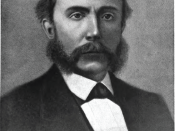Factors of the Industrial Revolution By: Efrain DaVila, Juan Huerta, prd.7 The changes that led to the decline of the frontier were just the beginning of widespread economic and social developments that started a whole new way of life at the end of the 19th century. The availability of natural resources, new inventions, and a receptive market combined to start an industrial boom. Large businesses grew larger, and workers united to demand higher pay, shorter hours, and safer working conditions. You will learn about these significant developments and how they became that way in the next paragraphs.
Starting in 1840, a Canadian geologist Abraham Gesner realized kerosene could be used to light lamps and how to distill it. The industrialization of America was underway. The next important event was the drilling for oil with the steam engine, which was discovered by Edwin LeDrake. The oil boom spread through Kentucky, Ohio, Indiana, and Illinois.
Petroleum-refining industries grew up in Cleveland and Pittsburgh , as entrepreneurs hurried to make oil into kerosene. Gas at the time, was thrown away. Yet when the automobile was invented, it became the most important black gold. In 1887, rich iron ore deposits were found along the Merabi Range of Minnesota. At the same time the coal production went from 33 million tons in 1870 to 250 million tons in 1900. The growth of railroads influenced Americans' concept of time, space, industries, and businesses in which they worked. The outcome of this was the growing industries of iron, coal, steel, lumber, and glass to keep up with the demand for railroads. This was the main factor for the spread of new towns and markets, and of course rich opportunities for visionaries and profiteers.
Rails made local transit reliable and westward expansion possible for business as well as...


